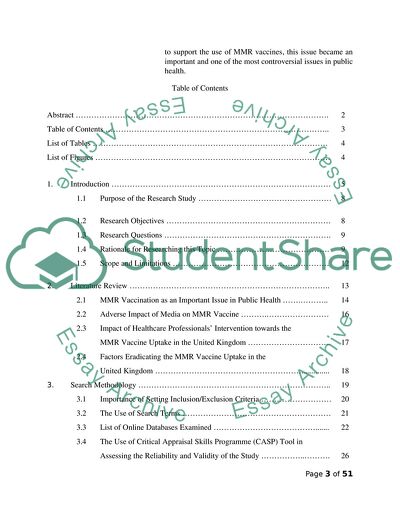
- Home
- Free Samples
- Premium Essays
- Editing Services
- Extra Tools
- Essay Writing Help
- About Us
- Studentshare
- Subjects
- Health Sciences & Medicine
- Investigating Factors Influencing Low MMR Uptake in the UK
Investigating Factors Influencing Low MMR Uptake in the UK - Research Paper Example

- Subject: Health Sciences & Medicine
- Type: Research Paper
- Level: Undergraduate
- Pages: 36 (9000 words)
- Downloads: 0
- Author: stoy
Extract of sample "Investigating Factors Influencing Low MMR Uptake in the UK"
The study is composed of five (5) major chapters. The first chapter presents a general overview of the research topic. The second chapter focused on the literature review. The third chapter focused on discussing the search method used in the completion of the literature review (i.e. the use of search words or search terms, online databases, inclusion and exclusion criteria, critical appraisal, etc.). The fourth chapter discussed the findings based on the journals reviewed. the fifth chapter focused on the study conclusion, recommendations for future study, and a short personal reflection regarding the research topic.
Conclusion: The low MMR vaccine uptake throughout the United Kingdom was triggered by Wakefield’s publication on the link between autism and MMR vaccines. Even though the MMR vaccine is effective in preventing the health and socio-economic consequences of measles, mumps, and rubella, a lot of parents are reluctant and unsure about the safety of MMR vaccination. Since public health workers must educate, convince, and motivate parents to support the use of MMR vaccines, this issue became an important and one of the most controversial issues in public health.
Measles is a kind of contagious disease that can easily spread through the air or direct contact with secretions that are infected by measles whereas mumps is a kind of disease that can be easily transferred through air or salivary secretions (Young, 2010, pp. 158 – 163). On the other hand, rubella a.k.a. German measles is a type of disease that can cause miscarriage or birth defects each time a pregnant woman gets rubella infection during the 1st quarter of pregnancy (i.e. cause blindness, deafness, and retardation in babies) (Young, 2010, p.164; Shmaefsky, 2009, p. 58). Applicable in England and Wales, Public Health England reported that the confirmed cases of measles and mumps have significantly increased from 112 and 94 in 1996 up to 1,843 and 4,035 in 2013 respectively (Public Health England, 2014a).
CHECK THESE SAMPLES OF Investigating Factors Influencing Low MMR Uptake in the UK
Corruption of Powers in Current Organizational Models
Sports Betting Industry in the United Kingdom: Current Issues
Patient Engagement in Decreasing Medication Wastage at SOPD
Factors That Influence Measles Immunisation Uptake in England
Factors that Influence Measles Immunization in the UK
National Express UK - Challenges of Financial Management
Medical Screening
Challenges of Autism Disorder

- TERMS & CONDITIONS
- PRIVACY POLICY
- COOKIES POLICY